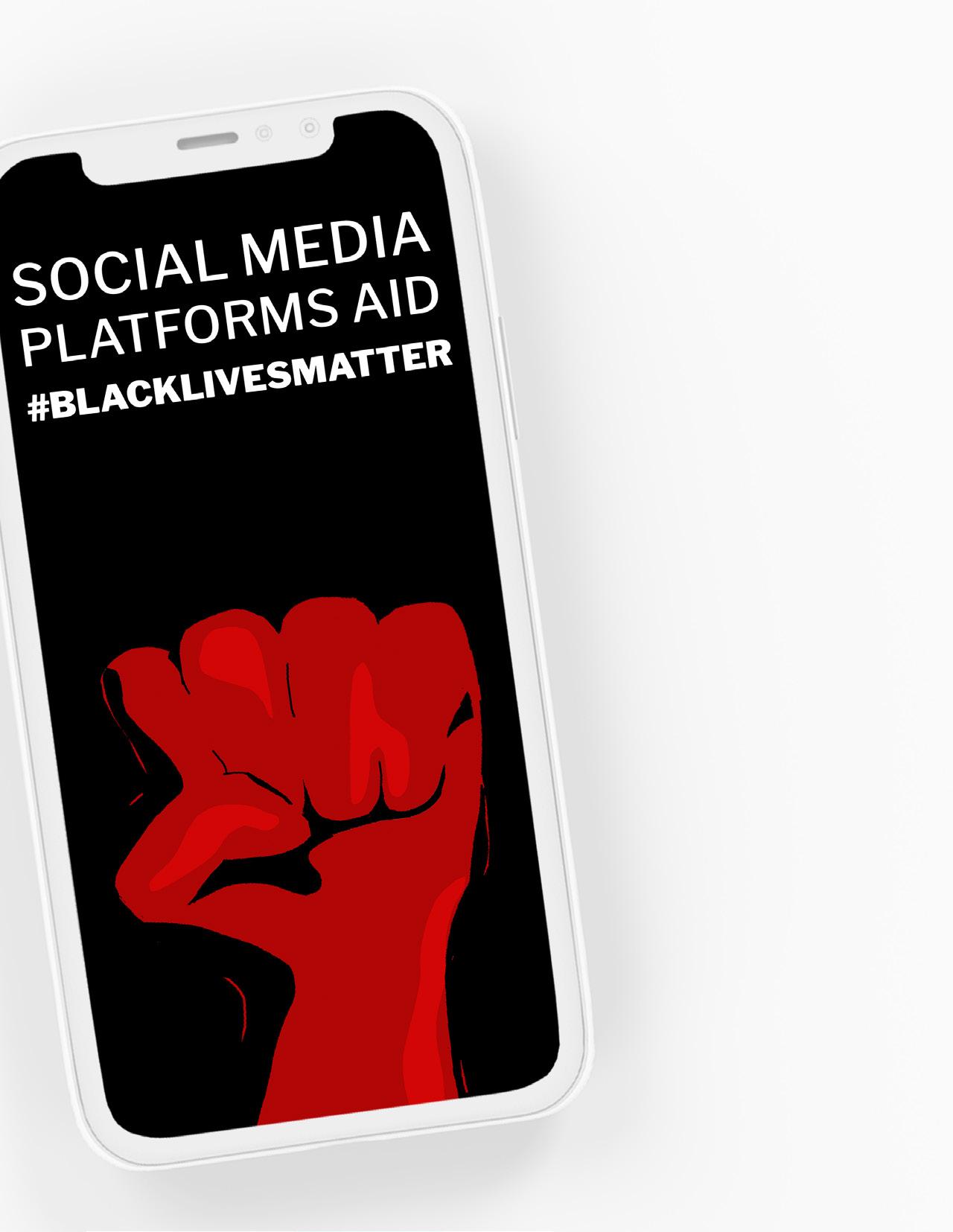
4 minute read
Social Media Platforms Aid #BLACKLIVESMATTER
Claudia Ugbana Asha McClendon
In the span of seven years, BLM has gained a wider audience due to the influence of social media.
Advertisement
This year has been one for the books, as a worldwide population of individuals can attest. While the world was rocked by a global pandemic and a wave of other catastrophic events, the reemergence of the Black Lives Matter (BLM) movement has un- doubtedly become one of the biggest initiatives to impact U.S. history.
On May 25, the video of a police officer kneeling on George Floyd’s neck, which led to his death, circu- lated the internet and caused a massive nationwide outrage. Millions of Americans (and allies from other countries) gathered in mass protests to end the vi- olence and systematic racism against Black people in the U.S.
The core of the Black Lives Matter conversation originated and surged through social media, an undeniable tool that has aided and expanded the reach of the movement. Platforms such as Twitter,
Facebook, Instagram, Tiktok, YouTube and a variety of other smaller social media platforms have become the primary resources for anti-racism activism and general information on the movement and its origination.
The famous slogan first popped up in a 2013
Facebook post following the acquittal of George
Zimmerman, a police officer who shot and killed 17-year-old unarmed Trayvon Martin. The severity of that event was no different from the unjust killing of George Floyd, however, its reception was entirely different. The phrase which then turned into a prominent hashtag was largely used after the death of Martin, but mostly faced criticism and died off social media platforms as the world seemingly moved on. Now, seven years later, Black Lives Matter has become a force that shows no signs of dying down.
The creation and evolution of the movement In 2013, three radical Black organizers found- ed a movement and organization that has influenced how Black Americans are per- ceived in the U.S. today. Alicia Garza, Pa- trisse Cullors and Opal Tometi created a Black-centered movement in response to the acquittal of Martin’s murderer, and now the project is a member-led organ-
isation of more than 40 chapters across the globe. The official website for Black Lives Matter describes the term as “an ideological and political intervention in a world where Black lives are systematically and intentionally targeted for demise.” With its creation, the three women sought to affirm Black individuals with ideas that they are an important part of society that shall continue to uplift and make vital contributions. The majority of the growth of the movement is attributed to the Ferguson and St. Louis community, who bravely supported the movement in 2014 after another senseless killing of an unarmed young Black man, Mike Brown. Brown’s murder created an uproar of protests much similar to the ones witnessed this year.
The work done in Ferguson was only the beginning. It became evident that the movement needed to become more globalized to reach more Black people across the country. This is where the impact of social media came into play, catapulting the Black Lives Matter movement into an enormous network.
The undeniable impact of social media
A huge importance of social media is its availability to millions of people across the world. Modern day civil rights activists have the advantages that activists of the 1960s and 1970s did not have, and can rely on social media to provide information on protests, videos of violent arrests, bail out funds and other organizations that aid Black individuals.
According to data collected by the Social Media Analytics Center at the University of Connecticut, the movement saw the most tremendous growth in a 30-day span after Floyd’s death with the slogan mentioned a total of 80 million times across Twitter, Facebook, Reddit and blogs. Mentions of the slogan didn’t just dominate social media. The protests that followed were reported to be the most searched topic in the U.S. Google search history.
Social media continued to aid the movement when we saw other trends make an appearance. In June, #BlackOutTuesday emerged on Instagram. Influencers, brands and bloggers all posted black boxes to their Instagram pages in support of the movement. The idea behind this new movement was to fall silent on social media platforms in order to amplify #BlackLivesMatter. From this, we also saw other initiatives arise such as #TheShowMustBePaused and #SayTheirNames.
While mentions continued to skyrocket, the most impact social media had was the direct aid to Black individuals. Social media influencers rallied behind each other and Black-owned businesses, and urged people to purchase from these brands. The spending power of Black consumers grew as they supported Black-owned businesses and initiatives which didn’t have much prominence prior to the movement. Celebrities also participated in this movement by exclusively purchasing from these brands and advertising their products on social media platforms at no cost.
What happens next?
It’s safe to say it would be inherently impossible to predict the future of the Black Lives Matter movement, as it would be impossible to predict the future of something as dire as a civil rights movement. Some people have begun speculating that talk of the movement has already begun to die down and commitment to the cause has shifted to other things, like the upcoming presidential election.
The protests were a huge part of the movement that surged over the past few months, with thousands of people marching in solidarity with Black individuals across the nation. The numbers have since depleted, with a much lower number of people who are still out there protesting.
The greatest fear for most people lies in the notion that the system will continue to fail Black individuals, and the hard work gathered over the last several years will be coupled up to something as simplistic as a social media trend.









